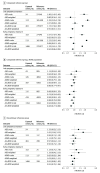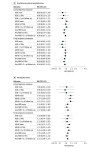Prescription Stimulant Use During Pregnancy and Risk of Neurodevelopmental Disorders in Children
- PMID: 38265792
- PMCID: PMC10809143
- DOI: 10.1001/jamapsychiatry.2023.5073
Prescription Stimulant Use During Pregnancy and Risk of Neurodevelopmental Disorders in Children
Abstract
Importance: Use of medications for attention-deficit/hyperactivity disorder (ADHD) during pregnancy is increasing in the US. Whether exposure to these medications in utero impacts the risk of neurodevelopmental disorders in children is uncertain.
Objective: To evaluate the association of childhood neurodevelopmental disorders with in utero exposure to stimulant medications for ADHD.
Design, setting, and participants: This cohort study included health care utilization data from publicly insured (Medicaid data from 2000 to 2018) and commercially insured (MarketScan Commercial Claims Database data from 2003 to 2020) pregnant individuals aged 12 to 55 years in the US with enrollment from 3 months prior to pregnancy through 1 month after delivery, linked to children. Children were monitored from birth until outcome diagnosis, disenrollment, death, or end of the study (December 2018 for Medicaid and December 2020 for MarketScan).
Exposures: Dispensing of amphetamine/dextroamphetamine or methylphenidate in the second half of pregnancy.
Main outcomes and measures: Autism spectrum disorder, ADHD, and a composite of any neurodevelopmental disorder were defined using validated algorithms. Hazard ratios were estimated comparing amphetamine/dextroamphetamine and methylphenidate to no exposure.
Results: The publicly insured cohort included 2 496 771 stimulant-unexposed, 4693 amphetamine/dextroamphetamine-exposed, and 786 methylphenidate-exposed pregnancies with a mean (SD) age of 25.2 (6.0) years. The commercially insured cohort included 1 773 501 stimulant-unexposed, 2372 amphetamine/dextroamphetamine-exposed, and 337 methylphenidate-exposed pregnancies with a mean (SD) age of 31.6 (4.6) years. In unadjusted analyses, amphetamine/dextroamphetamine and methylphenidate exposure were associated with a 2- to 3-fold increased risk of the neurodevelopmental outcomes considered. After adjustment for measured confounders, amphetamine/dextroamphetamine exposure was not associated with any outcome (autism spectrum disorder: hazard ratio [HR], 0.80; 95% CI, 0.56-1.14]; ADHD: HR, 1.07; 95% CI, 0.89-1.28; any neurodevelopmental disorder: HR, 0.91; 95% CI, 0.81-1.28). Methylphenidate exposure was associated with an increased risk of ADHD (HR, 1.43; 95% CI, 1.12-1.82]) but not other outcomes after adjustment (autism spectrum disorder: HR, 1.06; 95% CI, 0.62-1.81; any neurodevelopmental disorder: HR, 1.15; 95% CI, 0.97-1.36). The association between methylphenidate and ADHD did not persist in sensitivity analyses with stricter control for confounding by maternal ADHD.
Conclusions and relevance: The findings in this study suggest that amphetamine/dextroamphetamine and methylphenidate exposure in utero are not likely to meaningfully increase the risk of childhood neurodevelopmental disorders.
Conflict of interest statement
Figures





